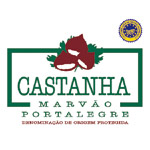Description
The Castanha Marvão-Portalegre PDO chestnuts come from the Castanea sativa Mill species in Bárea, Clarinha, Enxerta and Bravo varieties. The first two kinds make up 75% of the total production.
Production Area
Castanha Marvão-Portalegre PDO chestnuts are grown in the municipal areas of Marvão, Castelo de Vide and Portalegre, in the Portalegre district.
Production Method
Fresh chestnuts are collected from the ground, sorted (the bad ones are removed) and graded (into less than or more than 24 mm in diameter) and packed. Some chestnuts are dried. This is carried out by a sweating process in special ovens and takes about 40 days.
Appearance and Flavour
Castanha Marvão-Portalegre PDO chestnuts have quite a hard, tough skin and are light or dark brown in colour and shiny. They are large in size, have high water content and a very distinctive flavour.
History
The history of the Castanha Marvão-Portalegre PDO is dependent on the production area. In fact, thanks to the climate, chestnut trees thrive in the north eastern part of the Alentejo region and dominate the landscape. The tree and its fruit have each made their contribution to the customs and culture of the local inhabitants of this land.
Gastronomy
Castanha Marvão-Portalegre PDO chestnuts can be easily stored just as they are or they can be frozen. They can also be made into conserves or preserved in syrup. They are used in many local dishes such as chestnut soup and turkey with chestnuts. They are also made into flour and used in cake making.
Marketing
These chestnuts are sold as Castanha Marvão-Portalegre PDO in the following two varieties: castanha fresco (fresh), seca e pilada (dried and peeled). They are sold in transparent plastic containers in the following weights: 250 gr, 500 gr, 1 kg and 2 kg.
Distinctive Features
Castanha Marvão-Portalegre PDO chestnuts have a particular flavour which is given by the unique characteristics of the area where they grow. This gives them their distinctive flavour and taste.







